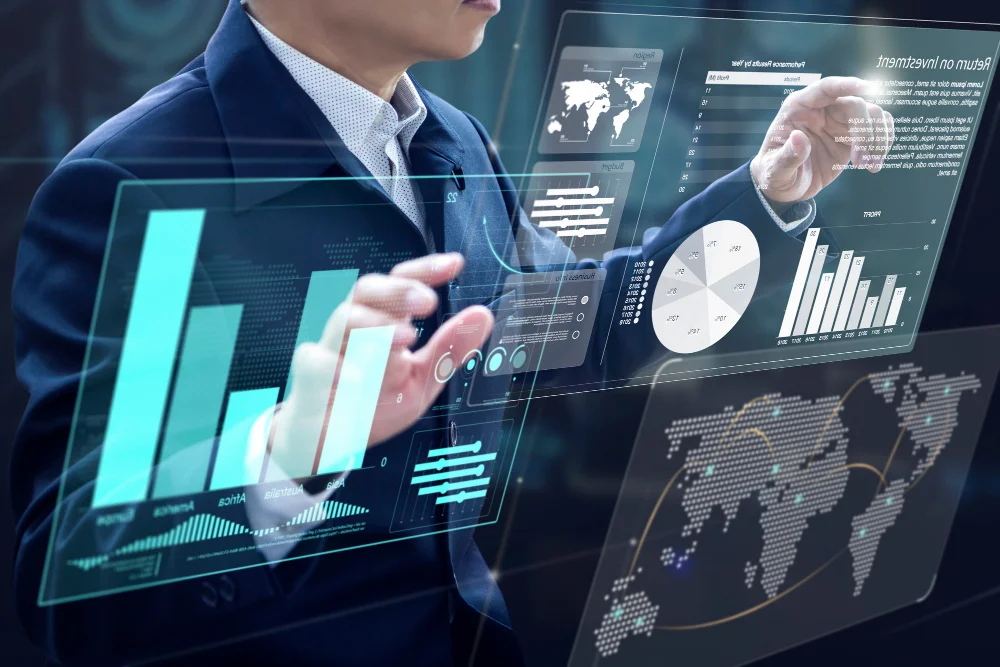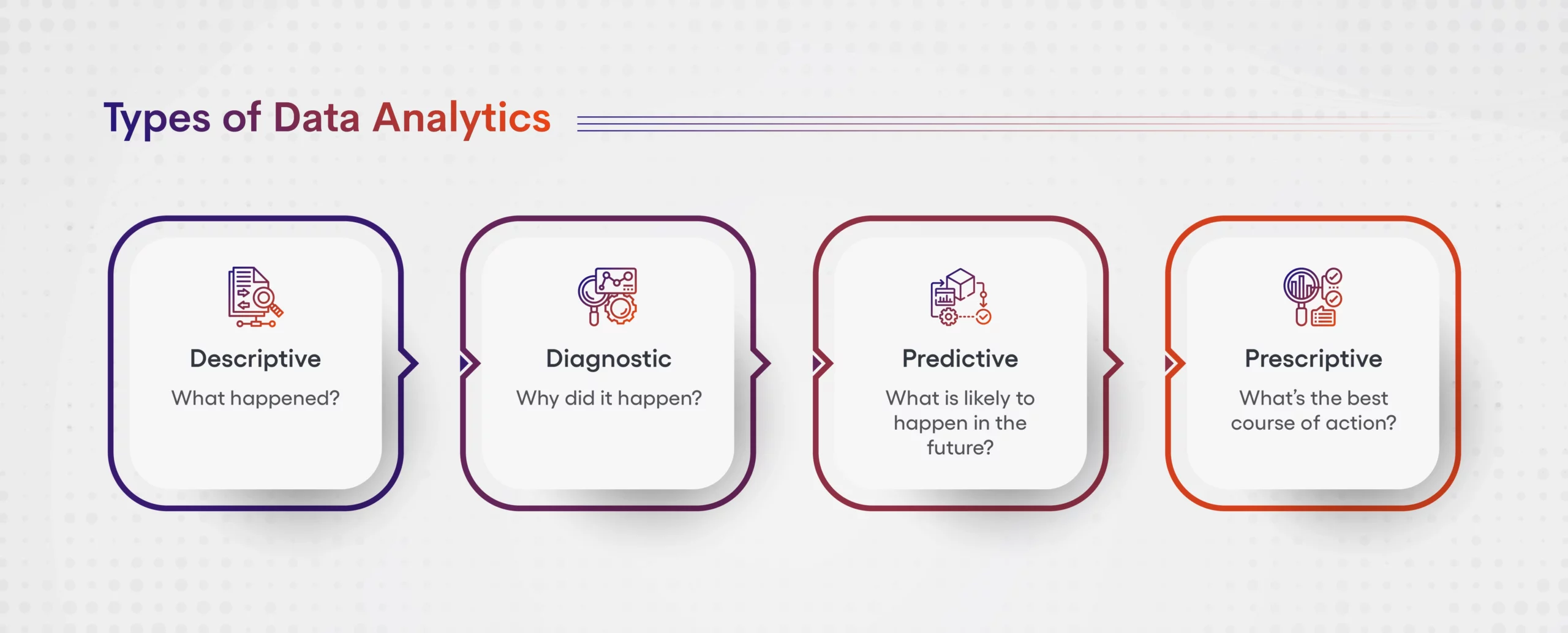- Blog
- May 2, 2023
Data Analytics – The Hub of endless opportunity

- Blog
- May 2, 2023
Data Analytics – The Hub of endless opportunity
The world is heading towards an increasingly data-driven future where data analytics will play a crucial role in various industries and sectors. Data has various forms such as structured, unstructured, and semi-structured. Data that has a defined format like an Excel sheet is more structured, while unstructured data includes videos and images. Semi-structured data, like emails, lies in between. Giving meaningful insights to these forms of data is the primary role played by Data Analytics.
What is Data Analytics?
Data analytics is the process of examining large and varied datasets to extract meaningful insights and inform decision-making. It involves a range of techniques, such as statistical analysis, data mining, machine learning, and data visualization, to identify patterns, trends, and relationships within data.The market for high-performance data analytics will reach USD 187.57 billion in 2026.
Benefits of Data Analytics
- Better decision-making: By analyzing data, organizations can make data-driven decisions based on facts and evidence rather than intuition or guesswork.
- Improving operational efficiency: Data analytics can help identify inefficiencies in processes and operations, allowing organizations to optimize their processes and reduce costs.
- Understanding customer behavior: By analyzing customer data, organizations can gain insights into customer behavior and preferences, which can inform marketing strategies, product development, and customer engagement.
- Identifying new business opportunities: Data analytics can help identify new market opportunities, customer segments, and emerging trends, allowing organizations to stay ahead of the competition.
- Risk management: By analyzing data, organizations can identify potential risks and take proactive measures to mitigate them.
Trends shaping the world of Data Analytics
- Emergence of Artificial Intelligence (AI) and Machine Learning (ML) – Future data analytics processes will incorporate advanced AI and ML technologies to automate and optimize data analysis.
- Data privacy and security taking center stage – As the demand for data analytics grows, businesses and government bodies are taking drastic measures to ensure the privacy and security of personal data. Data analytics practices have to abide by various laws, regulations, and compliance requirements around data privacy and regulations.
- Real-time data analytics is a clear need: With the rise of Internet of Things (IoT) and edge computing, organizations are progressively adopting real-time data analytics to make faster and more informed decisions.
- Modernization with Cloud: Cloud solutions have revolutionized modern businesses by introducing unprecedented flexibility. Companies are leveraging the benefits of the cloud by migrating their data analytics operations.
- Growing demand for Data Visualization – As data volumes continue to rise, the demand for efficient data visualization tools increases. These tools are crucial for analysts to quickly identify trends and patterns within data.
Types of Data Analytics

- Descriptive analytics: The simplest form of analytics is descriptive, creating a base for all other data types. It can quickly summarise what occurred or is occurring by drawing trends from the raw data. What happened is answered by descriptive analytics. Charts, graphs, and maps can clearly and understandably display data trends. Dips and spikes make data visualization a natural match for communicating descriptive analysis.
- Diagnostic analysis:Using data to identify the reasons behind patterns and correlations between different variables is known as diagnostic analytics. One can think of it as the natural progression of using descriptive analytics to find trends. Manual analysis, algorithmic analysis, or statistical tools can be used for diagnostic purposes.
- Predictive analysis:Predictive analytics uses historical data with statistical modeling, data mining, and machine learning to forecast future results. Through data patterns, we can use predictive analytics to spot risks and possibilities. The revenue forecast for predictive analytics in 2025 is estimated to be USD 23.9 billion.
- Prescriptive analytics: Prescriptive analytics builds on predictive analytics and recommends the courses of action. Prescriptive analytics, in other words, demonstrates how to benefit from the predicted result. Data analysts will evaluate a variety of potential outcomes and potential company actions when performing prescriptive analysis. It is one of the difficult types of analytics that can entail working with algorithms, machine learning, and computational modeling techniques. A company’s ability to use prescriptive analytics significantly impacts decisions and ROI.
Data analytics use cases:
Every industry relies on data analytics for informed decisions to accompolish growth goals. In this blog article, we take a look at use cases for a selected list of industires such as aviation, healthcare, manufacturing, banking and retail as follows.
- Aviation:According to studies, the market for aviation analytics will grow to 7 billion in 2027. Routine reporting duties like the number of flights, passengers, distance, and more can automate with data analytics. It also produces performance metrics that help with subsequent analysis. By utilizing long lines, stepping up security, and using smart administration, airports can offer superior execution. The program supports real-time factor monitoring and personalization. They can even forecast customer behavior by using predictive analytics. Data analytics successfully boosts profits by employing ideas, like demand forecasting and differential pricing strategy.
- Banking:Government regulations and the substantial increase in data generation are the main forces behind the adoption of data analytics in the banking industry. As technology develops, customers are using more and more devices to start transactions (like smartphones), which boosts the volume of transactions. Banks can analyze market trends and decide whether to lower or raise interest rates for individuals across various areas due to advancements in big data analytics. Financial services are constantly utilizing data analytics to store data, gain business insights, and enhance scalability as the volume of electronic records rises.
- Healthcare:As of 2022, the size of the global healthcare analytics market was USD 35.3 billion, and from 2023-2030 it is anticipated to rise at a CAGR of 21.4%. EHRs keep track of and document your patient’s medical information, such as existing conditions and allergies, which helps to cut down on the need for pointless tests. By gathering information about a patient’s health and comparing the symptoms to a larger patient database, healthcare professionals can diagnose and manage patients more quickly, accurately, and successfully. Healthcare fraud is considerably less likely due to data analytics ability to identify anomalies more quickly and notify people right away.
- Manufacturing:Manufacturing analytics is the practice of collecting, cleaning, and analyzing machine data to forecast future machine usage, maintenance requirements, and failures. Sensors and gadgets can eliminate the need for manual data entry and documentation. Preventive maintenance is performed using manufacturing analytics while handling unplanned failures. Manufacturers can calculate the cost of raw materials more precisely if they have a clear idea of the time and effort needed for product development, planning production runs, and attaining profitability. Make more informed choices about enhancing, changing, or introducing new products by gathering data from active warranties and using manufacturing analytics.
- Retail:Retailers may now see a more comprehensive view of customer behavior, product consumption, and traffic patterns because of data analytics. Retailers may benefit from this information in the following ways:
-
- Boost sales by reconfiguring store layouts, enhancing pricing tactics, or introducing new products.
- Glean insightful information regarding the types of customers who are purchasing and how frequently they do so.
- Determine which regions need to have more marketing activity focused on them.
- Collecting and analyzing data, particularly on rivals and the industry as a whole, constitutes providing competitive intelligence.
Conclusion:
The future of our way of life and work is predicted to be drastically altered by data analytics. For many of our daily decisions, we already employ analytics in our technological devices. The possibility of the impossible is anticipated to be made possible by data analytics. As a result, the majority of businesses are increasingly making investments in data analytics capabilities to stay ahead of both known and unknowable competition. They are on their way to opening the door of enormous opportunity.
Overall, the world is heading towards a future where data analytics will continue to play an increasingly important role in every decision making process, innovation, and growth across diverse industries and sectors.




